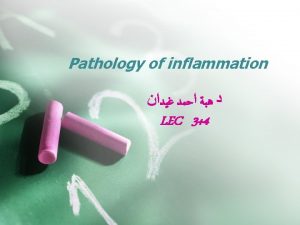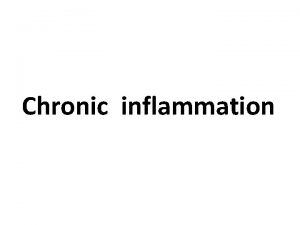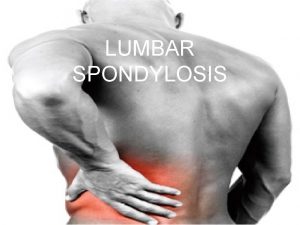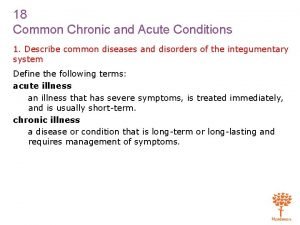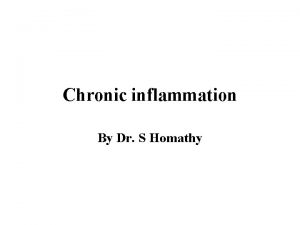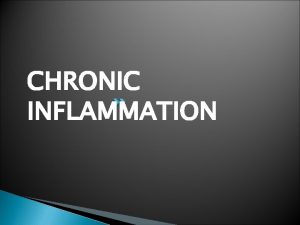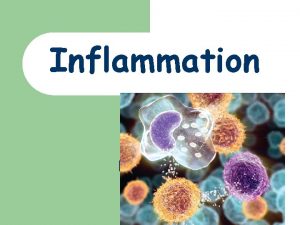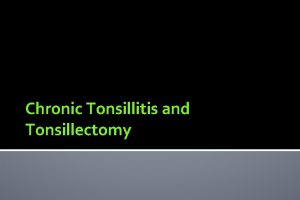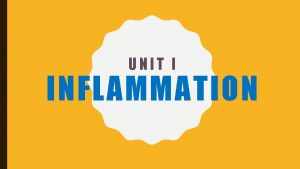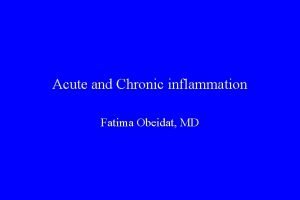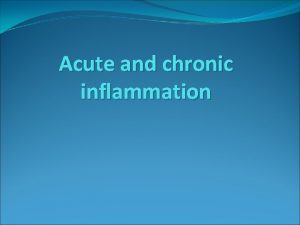UNIT I Inflammation INFLAMMATION CHRONIC INFLAMMATION DEFINITION AND










- Slides: 10

UNIT I Inflammation

INFLAMMATION

CHRONIC INFLAMMATION DEFINITION AND CAUSES. • prolonged process in which tissue destruction and inflammation occur at the same time • caused by one of the following 3 ways: 1. Chronic inflammation following acute inflammation. • tissue destruction is extensive, or the bacteria survive and persist in small numbers at the site of acute inflammation e. g. in pneumonia terminating in lung abscess. 2. Recurrent attacks of acute inflammation. • repeated acute inflammation happened e. g. in recurrent urinary tract infection leading to chronic pyelonephritis. 3. Chronic inflammation starting de novo. • infection with organisms of low pathogenicity is chronic from the beginning e. g. infection with Mycobacterium tuberculosis

GENERAL FEATURES OF CHRONIC INFLAMMATION • Differences in chronic inflammatory response depending upon – tissue involved – causative organisms General features characterising any chronic inflammation: • 1. Mononuclear Cell Infiltration. • 2. Tissue Destruction Or Necrosis. • 3. Proliferative Changes. 1. MONONUCLEAR CELL INFILTRATION. • Chronic inflammatory lesions are infiltrated by mononuclear inflammatory cells like phagocytes and lymphoid cells • Appear at site- by chemotaxis, local environment, and survival

• Other chronic inflammatory • Get activated due to cells – cytokines (lymphokines) – lymphocytes, – bacterial endotoxins – plasma cells, • Release biologically active – Eosinophils substances e. g. – mast cells – acid and neutral proteases • lymphocytes and macrophages – oxygen-derived reactive influence each other and metabolites release mediators of – cytokines inflammation • These causes– tissue destruction – neovascularisation – Fibrosis

2. TISSUE DESTRUCTION OR NECROSIS • Central features of most forms of chronic inflammatory lesions • By activated macrophages which release a variety of biologically active substances e. g. protease, elastase, collagenase, lipase, reactive oxygen radicals, cytokines (IL-1, IL -8, TNF-α), nitric oxide, angiogenesis growth factor etc. 3. PROLIFERATIVE CHANGES • Resultantly necrosis, • proliferation of small blood vessels and • fibroblasts is stimulated leads to formation of inflammatory granulation tissue. • Healing by fibrosis and collagen deposition takes place

SYSTEMIC EFFECTS OF CHRONIC INFLAMMATION Chronic inflammation is associated with following systemic features: 1. Fever. Invariably there is mild fever, often with loss of weight and weakness. 2. Anaemia. chronic inflammation is accompanied by anaemia of varying degree. 3. Leucocytosis. As in acute inflammation, with lymphocytosis 4. ESR is elevated in all cases of chronic inflammation. 5. Amyloidosis. Long-term cases of chronic pus forming (suppurative) inflammation may develop secondary systemic (AA) amyloidosis (Amyloid protein).


TYPES OF CHRONIC INFLAMMATION: Two types 1. Non-specific • Irritant substance produces a nonspecific chronic inflammatory reaction – with formation of granulation tissue – healing by fibrosis e. g. chronic osteomyelitis, chronic ulcer 2. Specific • Injurious agent causes a characteristic histologic tissue response e. g. tuberculosis, leprosy, syphilis

• Reference: Textbook of Pathology, by Harsh Mohan (Author), JAYPEE Publication
 Acute and chronic inflammation difference
Acute and chronic inflammation difference Pattern of acute inflammation
Pattern of acute inflammation Morphological patterns of acute inflammation
Morphological patterns of acute inflammation Chronic inflammation
Chronic inflammation Types of inflammation
Types of inflammation Definition of chronic toxicity
Definition of chronic toxicity Chronic care model definition
Chronic care model definition Definition of chronic toxicity
Definition of chronic toxicity Spondylo definition
Spondylo definition Unit 6 review questions
Unit 6 review questions Common chronic and acute conditions chapter 18
Common chronic and acute conditions chapter 18


